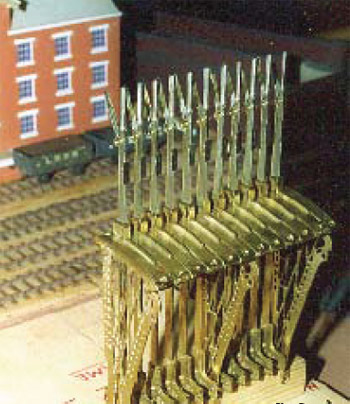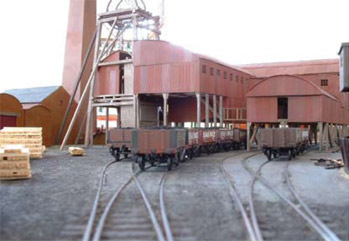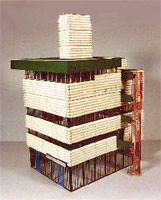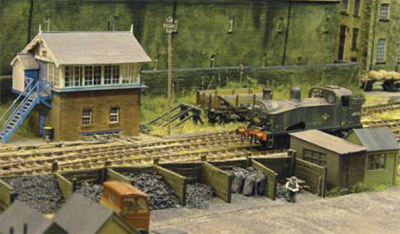A modelling philosophy expounded by Andrew Jukes
What P4 is - and isn't
 Now P4 is often seen as being mainly
about using very closeto- scale track and wheel standards, and of
course the choice of these standards is an essential feature of P4
modelling. That choice can easily be seen as leading to a more
difficult and demanding form of modelling and to some extent, and
depending on where you are starting from, this is likely to be
true. Even with recent progress in track which is easier to build and
with the continued development of ideas for converting or building
rolling stock, more construction work will be needed and more skills
will need to be acquired than for a typical OO gauge model
railway.
Now P4 is often seen as being mainly
about using very closeto- scale track and wheel standards, and of
course the choice of these standards is an essential feature of P4
modelling. That choice can easily be seen as leading to a more
difficult and demanding form of modelling and to some extent, and
depending on where you are starting from, this is likely to be
true. Even with recent progress in track which is easier to build and
with the continued development of ideas for converting or building
rolling stock, more construction work will be needed and more skills
will need to be acquired than for a typical OO gauge model
railway.
But what you should avoid assuming - and we hope this supplement shows this - is that the path you will be drawn along will be too difficult for you. People who could build a successful model railway to other standards could also build a successful P4 model railway, having taken a little time to understand the differences in approach.
The use of P4 standards has provided the impetus for much innovation in track, wheels, suspensions and locomotive drive systems. Of the modellers working to P4 standards, a number find the technical challenge continues to be their main interest. Just because you come across such people doesn't mean that you have to join them at the cutting edge - it is perfectly possible to build a P4 model railway using well-established methods. The most important point perhaps is that it should be done with care and with an awareness of what is important to make a railway work well.
Where P4 standards can lead
Adopting P4 standards opens up the possibility of building a model railway that is very accurate in almost every respect. Model locomotives with exact scale wheels standing on correctly proportioned track with close-to-scale flangeways seem to encourage us to look at other aspects of the model railway. If the rolling stock and track are accurate, what about the lineside equipment, what about the signal boxes and station buildings?
Are they correct for the period and railway, and do they properly match the rolling stock? And so it goes on. How to make the tiles on the roof of the cottage near the station look exactly right; what bond should be used for that brick wall next to the cottage?
But though the greater accuracy of the track and wheel standards may encourage this sort of attention to detail, it is still your choice how far you go. The much higher standards of ready-to-run OO gauge rolling stock, combined with the availability of P4 track which is easier to build, and the simplified methods of converting rolling stock to P4, can be seen as enabling more emphasis to be given to building an operating railway than on getting all the fine detail exactly right. Correct overall proportions, potentially smooth and realistic running combined with the detail and accuracy of much recent ready-to-run rolling stock are the key elements. These can provide the basis for a railway on which the satisfaction comes from following the operating procedures of the prototype and the local pattern of train movements.
If you are so minded, it is then a small step to want to interlock the signals and points and even to detect trains with track circuits, so that - as on a real railway - some aspects of correct operation are enforced. Accurate train formations, a working timetable - and so it goes on. It is up to you and the areas which intrgue you, but getting these right enhances the satisfaction in your modelling.
 “Each of us models railways for
reasons that may be hard to explain, but they will often be very much
our own reasons. Likewise, our main areas of interest will differ:
“Each of us models railways for
reasons that may be hard to explain, but they will often be very much
our own reasons. Likewise, our main areas of interest will differ:
- some enjoy collecting and displaying a fleet of rolling stock
- some have a particular interest in track or control systems
- and some aim to simulate the whole process of operating a railway
All perfectly valid reasons for pursuing our hobby and leading to a wide variety of end results in the kind of model railway we are likely to aim for.”
(Right)
The North East Finescale Folk built a lever frame to
ensure safety at Eccleston.
None of these steps to greater accuracy, whether in the fine detail included in the models or in the way the railway is operated, is exclusive to P4. But quite often, the person who uses P4 standards then wants to achieve similar standards of accuracy in other aspects of their modelling. Seeking information and acquiring skills to achieve this result becomes part of the enjoyment we can get from our hobby.
Looking at the real thing from the point of view of track and wheels leads to tackling other things similarly.
 The East of Scotland lads researched and
built the colliery which was the scene of the Redding pit
disaster.
The East of Scotland lads researched and
built the colliery which was the scene of the Redding pit
disaster.
 Jim Smith-Wright is working on Birmingham New St,
and this is the signalbox.
Jim Smith-Wright is working on Birmingham New St,
and this is the signalbox.
 Civil engineering of bridges and buildings were an
especial interest of the Crewe Area Group when building
Knutsford East Junction CLC (top of page).
Civil engineering of bridges and buildings were an
especial interest of the Crewe Area Group when building
Knutsford East Junction CLC (top of page).
On the other hand, in building Halifax King Cross (left), Steve Hall went for the gritty delapidation of industrial Yorkshire as steam gave way to diesel.
